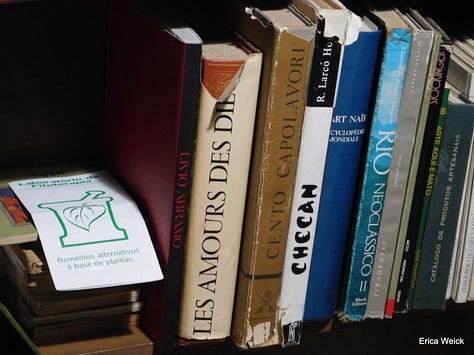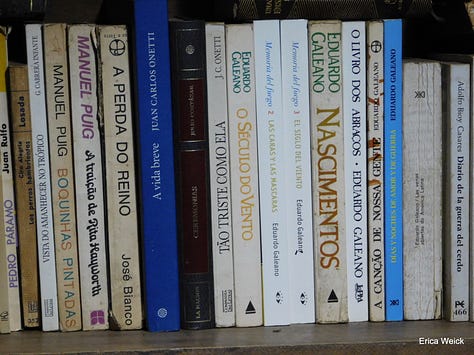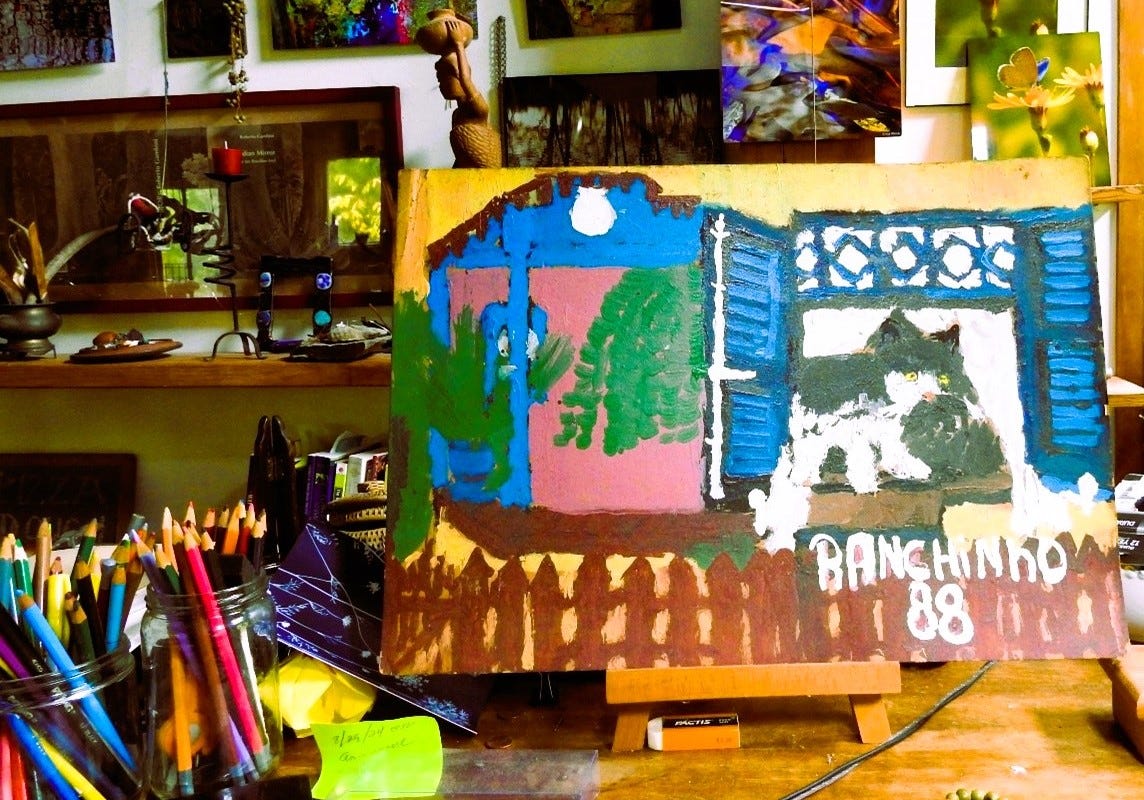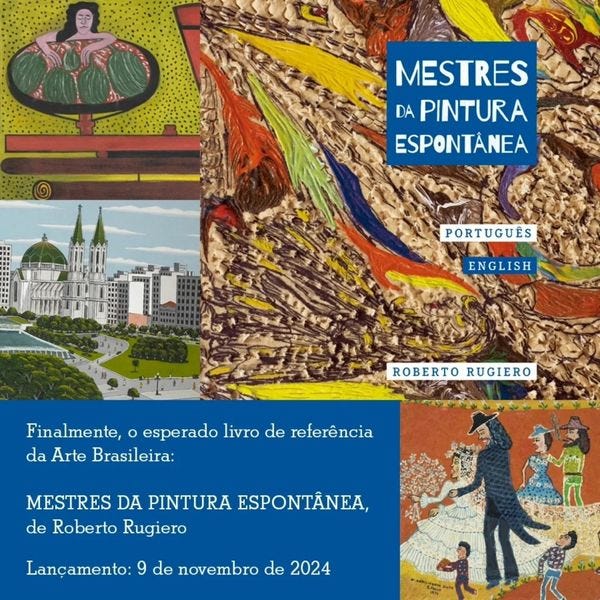There is a common notion appearing in many of the definitions of folk art - that it is simple. It is created by people who are not educated, who are sometimes illiterate. Or, by extension, who are primitive, naif, maybe diseased, perhaps deranged, cast on the outside.
Much like what we (the other ones,) are not!
And so, we come back again to high culture or to a culture that is in charge of definitions. Anyone who can enter the bus of high culture seems eager to jump right in. Then, once on the bus we yearn to be pure, primitive, simple and why not innocent, in that wild way, once again?
“I no longer understand what art means, exactly, for me. Here in this materialistic, automatic society of controls, where the emperor governs everything, where I live. Not just art from here but from all corners of what has been labeled, disseminated widely as the new networking global village. All edges are quickly smoothed over, carefully rounded, and made nice, abstract, matrix mother like nice. All unknowns made known by a rational scientific mind, father like? all nurture made safe by hopeful liberals, all frauds exposed. Or else?“
Crazy talk? Yes, definitely, that is me ranting madly. That precious moment when nothing much is understood and we are, momentarily free…
Ah but wait – we are now also told that we must practice art, and that art is the sure form leading to our soul salvation… is art then one of the items I must retrieve from the virtual shelves and present at the checkout line of the universal supermarket of the virtual manifested?
In this story, I wanted to stay with art, more specifically with folk art and with the many meanings I may find for the word – with folk understood as the people – a task of great complexity! The threads shoot out in all directions in time and space. What I believed ten years ago is modified and what anyone believed in space then, is certainly new and different now.
Trying to stay with the story telling about folk art and the people in the arts, I continue with an embedded tale of how I came to appreciate it:
Many years ago, I met a guy via email and through a friend, and we corresponded fiercely, for several years, we almost made it to fifteen. We met in person too, I traveled three thousand miles to where he lived, he reciprocated by traveling back a few years later. Then he stopped answering my email letters and within a week or two I found out he had died, in the middle of the covid pandemic contagion crisis. Gone.
Art and nature were our common interests, allied to a similarity in timing and culture, a love for the printed word and the uncanny ability to disagree, to argue and to remain friends. The forties, when we were born, the fifties growing up, the sixties and the seventies as prime times in our lives, the eighties and nineties in the surprise of adventure for the millennium beyond and the unknown twenty first.
As a scholar and researcher of artistic manifestations in Brasil (and in the world), Roberto Rugiero was an avid reader, sometimes reading for five, six hours or more, without pause.
I remember holidays spent on the farm, high up in the remaining Mata Atlantica forest, where we talked to no one, absolutely no one from the outside for days, as there were only the two of us, up there, in the solitude of books and art. So I learned a bit about folk art and quite a bit about listening to the silences inside me and inside the forest!



He became deeply involved with popular art in Brasil and understood from his own life experiences and as an art dealer, what it meant for an artist to go through creative processes. He was involved in their lives, and was a source of encouragement for them. Folk art in Brasil makes very slow indents into the mainstream of galleries and museums. He participated in the artistic process by becoming enmeshed in it, enacting it, like in a theater, while representing it. I guess this is some of what I learned about some of his life’s mission.
You may have heard of folk art, or of naïve art, or art brut. And you may have heard the term primitive art. In my view, all these terms carry the heavy weight of societal judgments from what I would call the members of the standard culture (as in sanctioned standard/national language/high culture). Folklore then is an example of artistic manifestations from the folk! From the people, the other ones, not ever us. Or when appropriate, yes, us included! And herein lies the paradox.
The term usually implies something real and echt, pure, not the bad that we do or our complicated imperfections? It also implies art that is created by those who are not us and who may be strangely vulnerable. We must collect them, honor and protect them…because we are not ever vulnerable, are we? they are our mirrors and we are the self appointed new motherly caretakers of the future Anthropod folks … ?
Roberto’s genius is that he understood many of these paradoxes, the societal impasses, the points of view, the standoffs. So, he coined the term spontaneous art as a preferred and less prejudiced alternative to folk, primitive, naif or popular art.
The question for me stays, with all the changes in my perceptions and thinking since then, and I am encompassing the period of 2000 and beyond:
What is art and who are the people who practice folk art, popular, primitive, brut, outsider ART?
As a pragmatist, Roberto came up with a fluid formula that helped him access artists and their work, in his frequent travels to their places, their realities. Creativity or what he termed the poetic note, the drive and the stamina to continue to create.
The world goes round and those who have substance come to light and prevail, as has happened and will continue to happen so often in the history of art. As this activity developed, I arrived at a formulation that has greatly assisted me as a guideline, and that time has shown to be efficient. This is a formula that consists of four items. Firstly, recognition of the artist´s originality. Next, a coherent path and creative freedom applied to the narrative, in other words, the dimension of its poetics. Staying power – the artist´s ability to continue on his path without slipping into repetition – is the next item for evaluation. And, last but not least, the technical and aesthetic fundamentals of a work of art.
Roberto also said that
“These definitions are, in my opinion, the ones that describe an artist´s language and lead to the projection of his importance, or, more objectively, his intrinsic value, the only element resistant to marketing and anointed with reliability to assess the importance of a work and its proper placement at a given moment.”
Quote from Viva o povo brasileiro, a beautifully illustrated catalogue for the 2016 exhibition in Rio de Janeiro.
An artist that impressed him greatly was Ranchinho, nicknamed after his habit of wandering the streets and taking refuge in abandoned cottages at the edge of town.

“A meu ver Ranchinho é um caso tão extraordinário e profundo quanto o de Artur Bispo do Rosário. Ambos fizeram da invenção artística a maneira de se situar no mundo. Embora não conhecesse nenhum pintor, nunca ter pisado numa galeria ou num museu, nem ter tomado lições, Ranchinho se expressa porque tem necessidade de criar e se comunicar. Seu trabalho possui uma excepcional capacidade de comunicação e nos causa assombro pela força dramática e poética das imagens, onde a temporalidade é um dos componentes fundamentais. Sentimo-nos de imediato invadidos pelo que George Steiner chama de “instantes milagrosos de iluminação e acuidade visionária”.
In my view, Ranchinho is a case as extraordinary and profound as that of Artur Bispo do Rosário. Both created a way to situate themselves in the world through their artistic inventions. Ranchinho did not know painters, had never set foot in a gallery or a museum, or had taken lessons, yet he expresses himself because he has a need to create and communicate. His work has an exceptional capacity for communication and causes us to be astonished by the dramatic and poetic force of the images, where temporality is one of the fundamental components. We immediately feel invaded by what George Steiner calls "miraculous instants of illumination and visionary acuity". A hora e vez de Ranchinho, text by Roberto Rugiero
It is like in this minor portrait, also by Ranchinho, a man tending to his stuff? a reminder of my own dad, from the deep south, near Patagonia, the horses, the gauchos. I love it!
The magazine Raw Vision, in print for more than thirty years, has an interesting article, with many brief histories of definitions of outsider art, the art that exists outside accepted cultural norms… a fascinating read with the question in mind, what is art and who are the people?
Further down, a historical snippet about art brut: “Dubuffet’s concept of Art Brut was of works that were in their “raw” state, uncooked by cultural and artistic influences.”
Wow, raw and uncooked!!! I need to revisit Claude Lévi-Strauss’ theories…
Then “Folk art is a simple and direct term that has become much used in North America. Originally pertaining to the indigenous crafts and decorative skills of peasant communities in Europe, the term was later applied to the simply-made practical objects of colonial days – a combination of charm and practical craftsmanship.”
Writer and philosopher Gloria Anzaldua offers some alternatives to the division of us and the others, that would always imply the creation of artist cooperatives where new language can be invented and practiced by the artists themselves, with new ways to communicate about conflict among cultures, without violence.
“The new tribalism disrupts categorical and ethnocentric forms of nationalism. By problematizing the concepts of who’s us and who’s other, or what I call nos / otras, the new tribalism seeks to revise the notion of “otherness” and the story of identity. The new tribalism rewrites cultural inscriptions, facilitating our ability to forge alliances with other groups.”p53 Gloria Anzaldua’s Light in the Dark.
I am waiting with keen interest for the published copy of Roberto Rugiero’s new book - “Mestres da pintura expontanea” - Masters of Spontaneous Painting. The launch will be on November 9 at the bookstore Martins Fontes in Sao Paulo. I participated in a small way with translations of some texts from Portuguese to English, as he, himself had asked me to do.
Carefully edited and assembled by his next of kin and friends, a posthumous celebration of his life and a new important reference for the powerful art of the people of Brasil.
Nothing simple about it…
If you are in the U.S., eligible to vote and consider yourself the people, vote! Click here to find out more about where and when to vote in your state.









Once again, wow! What a world I get to travel and learn with your writing.
just wonderful - thanks so much for this!!!